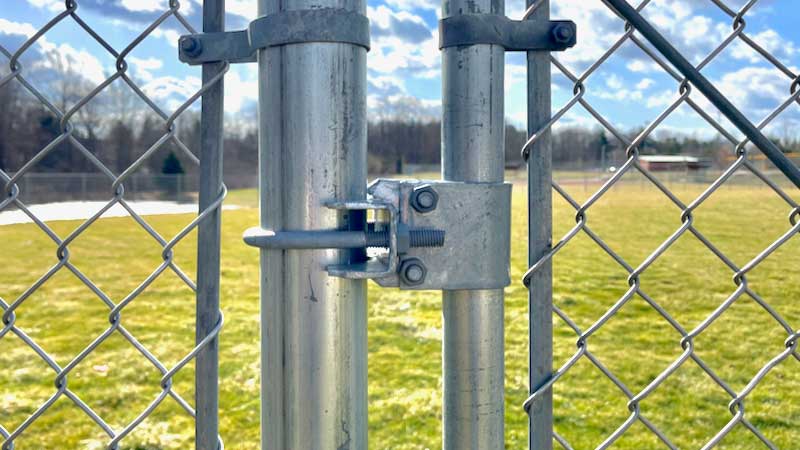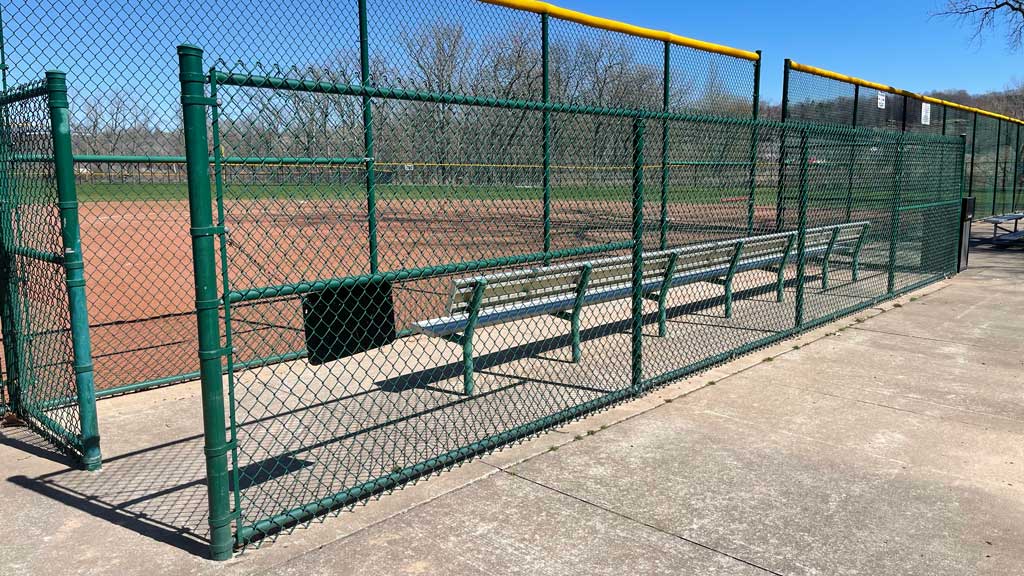A chain link fence gate provide a means of gaining access to fenced in areas. Gate widths are determined by what will be passing through the gate opening. For pedestrian use, a simple swing gate, also called a man gate works well.
When larger items like lawn tractors, trailers or vehicles are required to pass through a gate opening, double gates are installed in order to gain a wider width.
For larger commercial equipment and vehicles, rolling gates and cantilever gates provide the widest openings.
Therefore, in order to choose the correct type of gate, you must first have an idea of what its purpose is.
Types of Chain Link Fence Gates
There are many types of chain link fence gates to choose from. Most work well for both residential and commercial chain link fencing.
The only real difference between grades is the size and weight of the pipe used to fabricate the gates along with the size and strength of the gate hardware. Such as the hinges and latches.
Single Swing Gate
Swing gates come in many sizes. 3' - 6' wide are standard for residential chain link fences. However, commercial swing gates can cover larger openings.
Made from a single panel called a gate leaf, they hinge from one post and latch to another. They are the most common chain link gate type to install.
Double Drive Gates
A double drive gate for chain link fences combine two leafs that meet in the middle. A center latch post is not required.
Double gates cover twice the opening width. Perfect for larger equipment or lawn tractors. For commercial applications, a double drive gate can cover openings of 20' or larger. Installing the correct gate posts and hinges is key for larger gates.
Sliding and Rolling Chain link Fence Gates
Sliding and rolling gates roll parallel to fence lines. Therefore, requiring less room to function when compared to single and double drive gates.
A horizontal pipe track supports the rear of the gate. Wheels attached to the front to gate provide extra support. As a result, they are easy open and close.
Because the a rolling gate is supported at both ends, they offer the availability to cover wider gate openings.
Cantilever Chain Link Fence Gates
A cantilever rolling gate opens and closes parallel to the fence line like sliding and rolling gates. However, a cantilever gate includes a counter balance for support.
Large wheels known as cantilever rollers support the gate when closed. There are no track systems or support wheels making ground contact.
Cantilevers comes in two styles.
Pipe Framed Cantilever
A piped framed cantilever gate has framework made from the same round steel pipe as chain link fence. The large rollers attach to the gate externally, on the top and bottom rails.
Pipe framed gates cover openings from 12' up to 25' wide.
Aluminum Framed Cantilever
Aluminum track cantilever gates are built using square and rectangular aluminum tubing. As a result, the framework is more rigid and lighter in weight. Perfect for wider openings.
Another key difference is an internal trolley or truck roller that fits inside the gate frame. Safer than external rollers, they are also more reliable in icy and snowy climates.
Chain Link Vertical Lift Gate
Vertical lift gates are also referred to as pivot gates. A weighted counterbalance attached to a motor allows the gate to pivot upwards into the air. As a result, requiring no extra room in front or behind line of fence to open.
Because an operator is built in, vertical lift gates are found where access control is needed. Such as storage facilities and secure parking lots.
Barrier Gates
Barrier gates are made from piping without chain link mesh. Designed to prevent vehicle access rather than foot traffic.
Barrier gates are lightweight in design and come as singles or doubles depending on the required opening.
Learn More About Chain Link Fence Gates
Want to learn even more about the different types of gates for chain link fencing? Checkout our most recent blog posts below. We have all kinds of in-depth articles to help further educate you.








